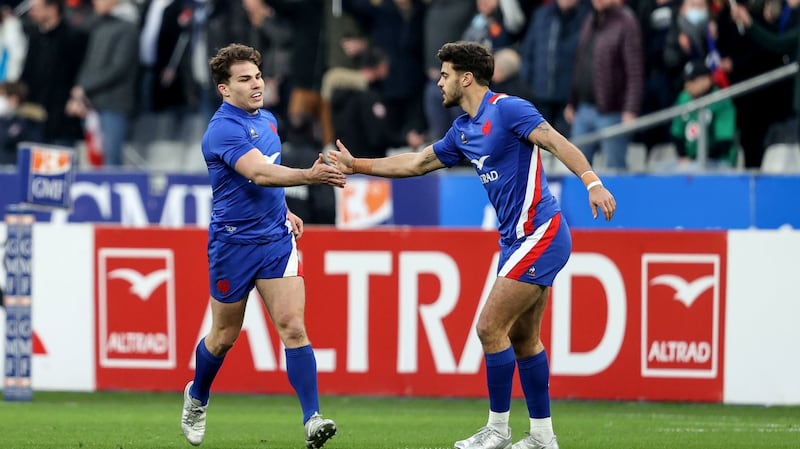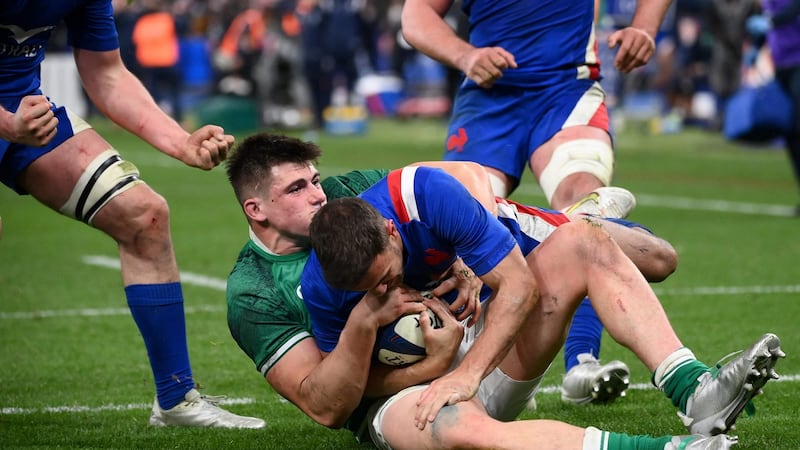The debate has been raging most of the week, and we’ve all seen the video.
So, how far forward was Romain Ntmack's pass to Antoine Dupont for France's opening try against Ireland? The reality is that it was not forward, and here's why.
Many, many passes are caught well in front of the point at which the pass was delivered – it’s all about the physics law of relative velocity, with the ball travelling forward through the air simply because the passer is running forward.
If the ball carrier is stopped, or driven backwards, his pass will look forward but it's not, even though referees are sometimes fooled, and whistle incorrectly. Ntmack was brought to ground as he passed, and that's where you'll find the false impression, the illusion; if he had continued running, there'd hardly have been a conversation about it. Doubting Thomases should reference the rugby pass video on YouTube.
Let's imagine when Ireland play England, Joey Carbery makes a similar break to deliver the same inside pass to Jamison Gibson-Park, for the winning try. I'll stack many pounds to a single penny that we'd all be appalled, demanding the head of the referee on a plate if he calls it forward, and we would be right.
We've watched other experiments to the laws in operation, and there should be debate around some of these. When Dan Sheehan miraculously held up France's Melvyn Jaminet over the Irish goal-line, the on-field decision of the referee was 'no try', and the call stood because the replays showed no conclusive evidence that the ball had touched the ground, even though it might have.
So, instead of an attacking five-metre scrum to France, along came the new-fangled goal-line drop out, with the ball being handed over to Ireland to clear their lines, without any contest for possession. It was one heck of a reward for a try-saving tackle. Designed to discourage continuous pick and drives, it also saves time by avoiding another pesky nuisance of a scrum, which is no doubt one of the thoughts behind this copycat rugby league law, and that's a sad story of its own.
Next, to the 50:22 law, where the attacking team get the throw at the lineout for kicking from their own half and bouncing the ball into touch. It’s getting a lot of support: the reasoning is that teams need to bolster their backfield defence to stop this kick, and that leaves more space for the opposition to attack.

I’m not so sure that teams didn’t always do their best to cover off this type of kick, not wanting to have a lineout deep in their own 22, even when it’s their own throw.
Rewarding a team for kicking the ball off the field just seems plain wrong, and it also conflicts with the principles of the game’s own well written charter, which tells us that a team who kick the ball out of play is denied the throw-in, and the very logical reason is that they’ve failed to maintain continuity of play.
The subsequent lineout is very often followed by yet another maul which, as we know, is damn difficult to defend, and may well result in a try. It all seems very disproportionate, and this writer, for one, would prefer to see more running and passing, not more mauling.
There has always been a law that players may not fall on the ball as it emerges from a scrum or breakdown. This has now been clarified, they may do so when the ball has rolled a metre away. Uh, you may ask, who is going to measure that, hasn't it the propensity for marginal decisions? The result is that if the ball is out, but only just, the only option is to pick it up; in the white heat of battle, as Josh van der Flier and England's Tom Curry arrive at thundering pace, that metre may prove more than tricky to judge.
A recent schools cup match saw a fairly generous interpretation of what was a metre before a vital try. Such was the pace and intensity of play, it’d be unfair to question the referee, but it showed just how difficult things can be.
A couple of player safety experiments get an enthusiastic welcome. The ball carrier can no longer be latched on to by a team-mate on either side of him, as in a sort of flying wedge, no more than one latcher is now permitted, and they must stay on their feet. Tacklers must be very grateful that they won’t be confronted by an approaching mass of over three hundred kilos. The tap and drive five-metre attacking penalty might well be next on the safety agenda.

In recent times, we’ve seen some horrific cruciate ligament injuries to players who have been attempting to poach the ball, and, at last, they are being offered some protection -– while they may still be levered out of the ruck, it is now a penalty offence to target their lower limbs.
The offside law is not new, but it has been getting a huge amount of renewed attention. When Hugo Keenan clears long from deep inside his 22 every other Irish player in front of him is offside, they cannot move forward until Keenan has run past them, fair enough.
However, we’ve seen nearly mystifying penalties when the referee suddenly whistles, returning to penalise a player, in front of his posts, even though the opposition, now in possession, are over 20 metres away. It’s hard to see that the so-called offence has had any material effect; let’s have common sense rather than an over rigid approach.
The reason for this very tight interpretation is to ensure that as much space as possible is maintained, which is undoubtedly an unarguable necessity, and teams are getting the message. But when it becomes draconian, the word disproportionate pops up again, and we can only hope that one of these penalties does not decide a match in the race to the title. The problem is, it might.













